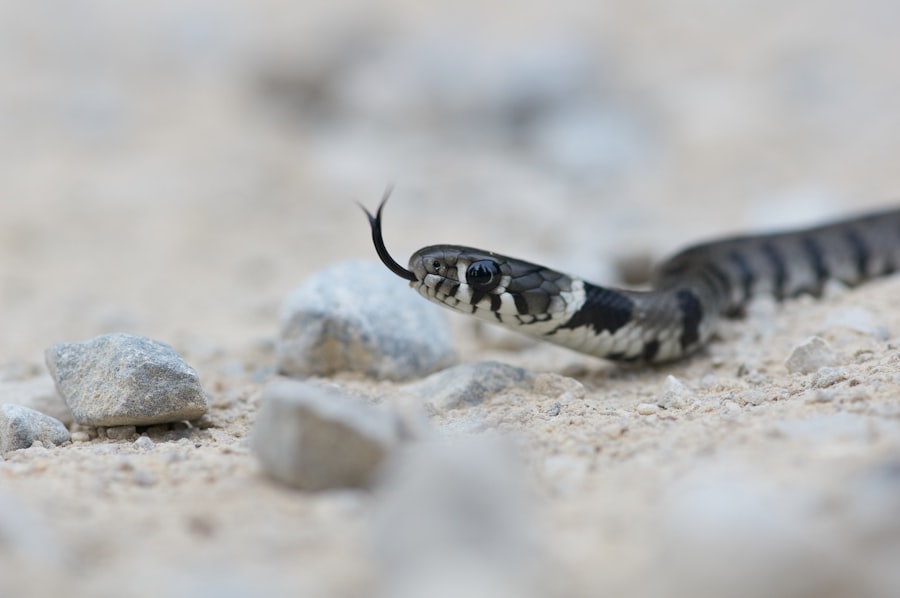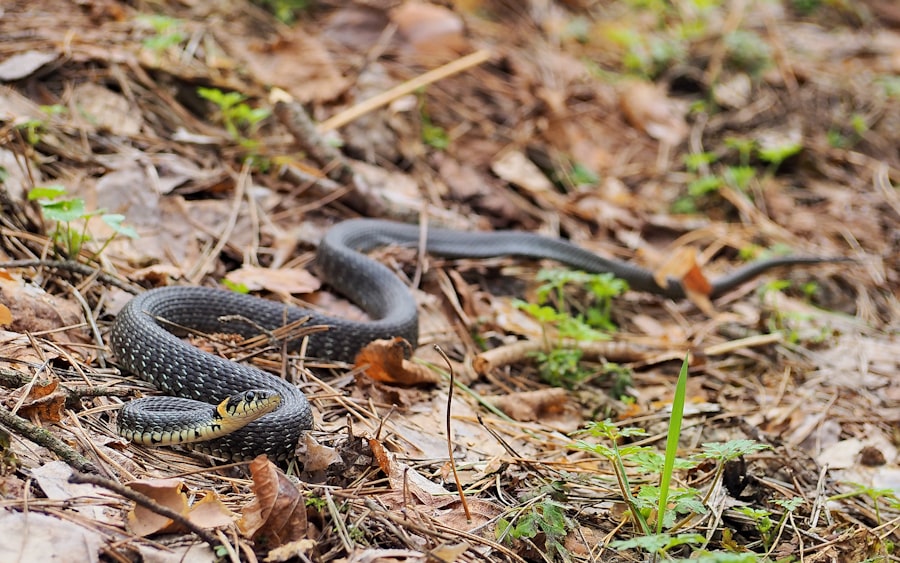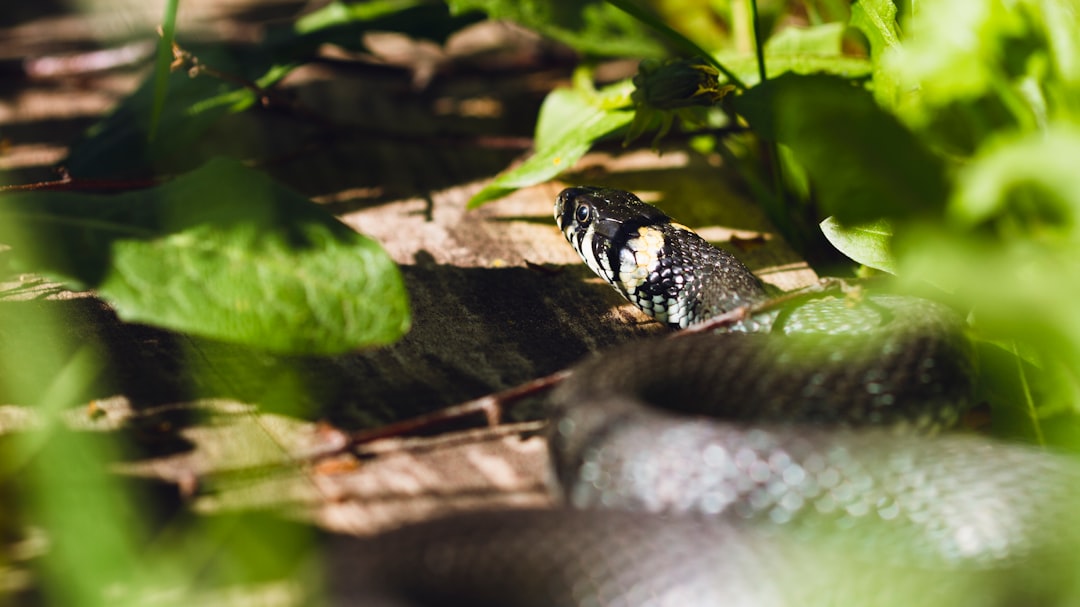Grass snakes, scientifically known as Natrix natrix, are a fascinating species of non-venomous snake that belong to the family Colubridae. These reptiles are often recognized for their striking appearance, characterized by a slender body, smooth scales, and a distinctive yellow or white collar behind their heads. Grass snakes are primarily found in Europe and parts of Asia, thriving in a variety of environments.
Their adaptability to different habitats, coupled with their unique behaviors, makes them a subject of interest for herpetologists and nature enthusiasts alike. The grass snake is often mistaken for other species due to its variable coloration, which can range from greenish to brown or even black. This variability serves as an effective camouflage in their natural habitats, allowing them to blend seamlessly into the surrounding vegetation.
Grass snakes are also known for their aquatic tendencies; they are excellent swimmers and are frequently found near water bodies such as ponds, lakes, and rivers. Their affinity for water not only influences their habitat preferences but also plays a crucial role in their feeding and reproductive behaviors.
Key Takeaways
- Grass snakes are non-venomous reptiles commonly found in Europe and Asia, known for their slender bodies and greenish coloration.
- They prefer habitats near water, such as wetlands, marshes, and meadows, and are often found basking in the sun or swimming in ponds and streams.
- Grass snakes primarily feed on amphibians, fish, and small mammals, using their keen sense of smell to locate prey and swallowing it whole.
- During the mating season, male grass snakes engage in combat to win over females, and after mating, females lay eggs in rotting vegetation or compost heaps.
- When threatened, grass snakes will release a foul-smelling musk and may also feign death to deter predators, such as birds of prey and mammals.
Habitat and Distribution
Grass snakes inhabit a wide range of environments across Europe and parts of Asia, demonstrating remarkable adaptability. They are commonly found in wetlands, marshes, and areas with abundant vegetation, which provide both cover and hunting grounds. The presence of water is a significant factor in their habitat selection, as grass snakes are often seen basking on the banks of ponds or swimming in shallow waters.
They thrive in regions with a mix of open spaces and dense foliage, which allows them to hunt effectively while remaining concealed from potential predators. The distribution of grass snakes extends from the British Isles to Scandinavia and down to the Mediterranean region. They are particularly prevalent in countries like Germany, France, and Italy.
In addition to their widespread presence in Europe, grass snakes have also been recorded in parts of Asia, including Turkey and the Caucasus region. Their ability to adapt to various climates and landscapes has contributed to their success as a species. However, local populations may vary significantly based on environmental conditions and human activities that impact their habitats.
Diet and Feeding Behavior

Grass snakes are primarily carnivorous, with a diet that mainly consists of amphibians, particularly frogs and toads. Their hunting strategy involves stealth and patience; they often lie in wait for unsuspecting prey to come within striking distance. Once an opportunity arises, grass snakes use their quick reflexes to capture their meal with a swift bite.
Reproduction and Mating Behavior
| Species | Mating System | Reproductive Strategy |
|---|---|---|
| Humans | Monogamy, Polygamy | Internal fertilization, live birth |
| Lions | Pride-based polygyny | Mating season, dominant males mate with multiple females |
| Birds | Monogamy, Polygyny, Polyandry | Egg laying, elaborate courtship displays |
The reproductive cycle of grass snakes typically begins in the spring when temperatures rise and the days grow longer. During this time, males engage in elaborate courtship displays to attract females. These displays often involve intricate movements and posturing, where males may intertwine with one another in competition for the attention of a female.
The mating process can be quite competitive, as multiple males may pursue a single female, leading to intense interactions among them. After successful mating, female grass snakes exhibit oviparous reproduction, laying eggs rather than giving birth to live young. The number of eggs can vary significantly depending on the size and health of the female; typically, a clutch can contain anywhere from 10 to 40 eggs.
Females often seek out warm, moist environments to deposit their eggs, such as compost heaps or decaying vegetation, which provide the necessary warmth for incubation. The eggs incubate for several weeks before hatching, with young snakes emerging fully formed and ready to fend for themselves.
Defensive Behavior and Predators
When threatened, grass snakes exhibit a range of defensive behaviors designed to deter potential predators. One common tactic is to remain motionless and rely on their camouflage to blend into their surroundings. This passive defense mechanism can be highly effective in avoiding detection by both predators and human observers.
If they are discovered or feel particularly threatened, grass snakes may resort to more active forms of defense. In addition to camouflage, grass snakes can also release a foul-smelling musk from their cloacal glands when provoked. This unpleasant odor serves as a deterrent against predators that might consider them as prey.
In extreme cases, grass snakes may feign death by rolling onto their backs and becoming limp—a behavior known as thanatosis—which can confuse or dissuade attackers. Despite these adaptations, grass snakes still face threats from various predators including birds of prey, larger mammals, and even other reptiles.
Communication and Social Behavior

Grass snakes exhibit limited social behavior compared to some other reptile species; however, they do engage in specific forms of communication during mating season and territorial disputes. During courtship rituals, males utilize body language and physical displays to signal their intentions to females and rival males alike. These displays can include head bobbing or body undulations that convey readiness to mate or assert dominance.
While grass snakes are generally solitary creatures outside of the breeding season, they may congregate in certain areas during warmer months or when basking opportunities arise. These gatherings can lead to interactions among individuals that may involve subtle displays of dominance or competition for prime basking spots. Although they do not form social bonds like some other animals, these interactions highlight the importance of environmental factors in shaping their behavior.
Hibernation and Seasonal Behavior
As ectothermic animals, grass snakes rely on external temperatures to regulate their body heat. Consequently, they enter a state of hibernation during the colder months when temperatures drop significantly. Hibernation typically occurs from late autumn through early spring, depending on geographical location and climate conditions.
During this period, grass snakes seek out sheltered locations such as burrows or crevices where they can remain insulated from the cold. The timing of hibernation is crucial for their survival; it allows them to conserve energy when food is scarce and temperatures are inhospitable. As spring approaches and temperatures rise, grass snakes emerge from hibernation in search of food and mates.
This seasonal behavior is closely tied to environmental cues such as temperature changes and the availability of prey species.
Conservation and Human Interaction
Grass snakes face various threats due to habitat loss caused by urbanization, agricultural expansion, and pollution. Wetland drainage and the destruction of natural habitats have significantly impacted local populations across Europe.
Conservation efforts are essential to protect these reptiles and their habitats. Human interaction with grass snakes can be both positive and negative. While some people appreciate these creatures for their ecological role in controlling amphibian populations, others may fear them due to misconceptions about snakes in general.
Education plays a vital role in fostering coexistence; initiatives aimed at raising awareness about the ecological importance of grass snakes can help mitigate negative perceptions. Conservation programs that focus on habitat restoration and protection are crucial for ensuring the survival of grass snake populations in an ever-changing world.
If you are interested in exploring the multifaceted functions of art, you may want to check out this article on Indian aesthetics here. In a similar vein, just as the grass snake plays a unique role in its ecosystem, Mahatma Gandhi and B.R. Ambedkar had their own distinct approaches to understanding the ideas of India, as discussed in this article here. This sociological concept of understanding different perspectives and roles within a society can also be seen in the study of status, role, groups, culture, socialization, structure, function, social control, and change, as explored in this article here.
FAQs
What is a grass snake?
A grass snake is a non-venomous snake species found in Europe and parts of Asia. It is also known as the ringed snake or water snake.
What does a grass snake look like?
Grass snakes are typically green or brown in color with a yellow or white collar behind the head. They can grow up to 3 feet in length and have a slender body with dark markings along the sides.
What is the habitat of a grass snake?
Grass snakes are commonly found in grasslands, meadows, marshes, and wetlands. They are also known to inhabit gardens and farmland.
What do grass snakes eat?
Grass snakes primarily feed on amphibians, such as frogs and toads, as well as small mammals, birds, and their eggs. They are also known to consume fish and invertebrates.
Are grass snakes dangerous to humans?
Grass snakes are non-venomous and generally not considered dangerous to humans. They are shy and will usually flee when encountered by humans.
Do grass snakes make good pets?
In some countries, it is legal to keep grass snakes as pets. However, they require specific care and a suitable habitat, so it is important to research their needs before considering them as pets.
Are grass snakes protected species?
In many European countries, grass snakes are protected under wildlife conservation laws due to declining populations. It is illegal to harm or disturb them in their natural habitat.
























+ There are no comments
Add yours